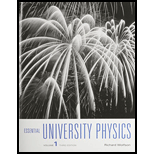
Concept explainers
Is a vertically bouncing ball an example of oscillatory motion? Of
Whether a vertically bouncing ball an example of oscillatory and simple harmonic motion.
Answer to Problem 1FTD
A vertically bouncing ball an example of oscillatory as the ball goes back and forth an equilibrium point and also of simple harmonic motion for small amplitude as the restoring force will be proportional to the displacement alone.
Explanation of Solution
An oscillatory motion is one in which a system goes back and forth an equilibrium point. A simple harmonic motion is one in which the restoring force is proportional to the displacement of the system.
When a ball is made to move in the vertical direction, the ball bounces of the ground and comes back to the ground. This happens in the same way as an oscillatory motion. The ball moves to and fro with respect to the ground and ergo, the vertically bouncing ball qualifies as an oscillatory system.
For a simple harmonic oscillator the restoring force acting on the material is proportional to the displacement. When the ball bounces vertically with low amplitude the ball will have a restoring force that is proportional to the amplitude which will keep it bouncing. Therefore, the bouncing ball will qualify as a simple harmonic oscillator when the amplitude of bouncing is low.
Conclusion:
Therefore, a vertically bouncing ball an example of oscillatory as the ball goes back and forth an equilibrium point and also of simple harmonic motion for small amplitude as the restoring force will be proportional to the displacement alone.
Want to see more full solutions like this?
Chapter 13 Solutions
Essential University Physics (3rd Edition)
Additional Science Textbook Solutions
College Physics: A Strategic Approach (3rd Edition)
Laboratory Experiments in Microbiology (12th Edition) (What's New in Microbiology)
Chemistry: A Molecular Approach (4th Edition)
Applications and Investigations in Earth Science (9th Edition)
Chemistry: An Introduction to General, Organic, and Biological Chemistry (13th Edition)
Organic Chemistry (8th Edition)
- I need help with how to solve this answer, thank you !arrow_forwardIs work function of a metals surface related to surface energy and surface tension? What is the need to the work function component in the math of tension of metal surfaces that cannot be provided by existing equations of surface energy and surface tension? What are the key differences in each parameter and variables that allow for a differentiation of each function? What has a more significant meaning work function, surface tension or surface energy? Are there real differences and meaning? Please clarify and if possible provide examples . Does surface tension dependant on thickness of a metal or type of metal surface all having the same thickness? Clearly temperature has a profound change on surface tension what other variables besides temperature are key to surface tension. What if any is there a connection between crystal structure of the element and surface energy and tension? This is NOT a Assignment Question!!!arrow_forwardThe cylindrical beam of a 12.7-mW laser is 0.920 cm in diameter. What is the rms value of the electric field? V/marrow_forward
- Consider a rubber rod that has been rubbed with fur to give the rod a net negative charge, and a glass rod that has been rubbed with silk to give it a net positive charge. After being charged by contact by the fur and silk...? a. Both rods have less mass b. the rubber rod has more mass and the glass rod has less mass c. both rods have more mass d. the masses of both rods are unchanged e. the rubber rod has less mass and the glass rod has mroe massarrow_forward8) 9)arrow_forward10) 11) 12) 13) 14) 15)arrow_forward
 Principles of Physics: A Calculus-Based TextPhysicsISBN:9781133104261Author:Raymond A. Serway, John W. JewettPublisher:Cengage Learning
Principles of Physics: A Calculus-Based TextPhysicsISBN:9781133104261Author:Raymond A. Serway, John W. JewettPublisher:Cengage Learning Physics for Scientists and Engineers: Foundations...PhysicsISBN:9781133939146Author:Katz, Debora M.Publisher:Cengage Learning
Physics for Scientists and Engineers: Foundations...PhysicsISBN:9781133939146Author:Katz, Debora M.Publisher:Cengage Learning University Physics Volume 1PhysicsISBN:9781938168277Author:William Moebs, Samuel J. Ling, Jeff SannyPublisher:OpenStax - Rice University
University Physics Volume 1PhysicsISBN:9781938168277Author:William Moebs, Samuel J. Ling, Jeff SannyPublisher:OpenStax - Rice University Physics for Scientists and Engineers, Technology ...PhysicsISBN:9781305116399Author:Raymond A. Serway, John W. JewettPublisher:Cengage Learning
Physics for Scientists and Engineers, Technology ...PhysicsISBN:9781305116399Author:Raymond A. Serway, John W. JewettPublisher:Cengage Learning Glencoe Physics: Principles and Problems, Student...PhysicsISBN:9780078807213Author:Paul W. ZitzewitzPublisher:Glencoe/McGraw-Hill
Glencoe Physics: Principles and Problems, Student...PhysicsISBN:9780078807213Author:Paul W. ZitzewitzPublisher:Glencoe/McGraw-Hill Classical Dynamics of Particles and SystemsPhysicsISBN:9780534408961Author:Stephen T. Thornton, Jerry B. MarionPublisher:Cengage Learning
Classical Dynamics of Particles and SystemsPhysicsISBN:9780534408961Author:Stephen T. Thornton, Jerry B. MarionPublisher:Cengage Learning





